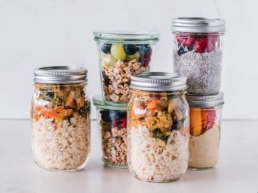By Taylor Winkel, First Mile Care DPP Coach and Registered Dietitian
Calories, calories, calories. People sometimes obsess over them. A calorie is a unit of energy in food and drink. We use calories to describe or measure how much energy your body could get from eating or drinking something. When you consume more calories than you expend in energy, your body stores the excess as body fat, which can result in weight gain over time.
When someone talks about following a diet and counting calories to lose weight, the first thing that comes to mind is sustainability. Most trendy diets are attractive because they offer a short-term fix, yet weeks or months later the weight returns because adopting a diet of too few calories and too many rules is not practical and sustainable in the long term. This is why the First Mile Care Diabetes Prevention Program (DPP) emphasizes identifying behavioral triggers to make small, incremental changes to eating, physical activity, and other healthy habits that result in lifestyle improvements.
The DPP promotes eating for health, not for short-term weight loss. First Mile Care coaches encourage participants to keep food journals to become more self-aware of eating habits. The DPP curriculum includes guidance on how to reduce calorie intake by controlling portion sizes and frequency of eating, and by swapping healthier foods for unhealthy items.
In addition to what you eat and drink, effective stress management, ample shut-eye, and regular exercise all play a role in lowering blood sugar and blood pressure levels, which can reverse prediabetes and reduce the risk of heart disease, along with other health benefits.
The calorie-energy connection
The ideal number of calories varies for each person. The Academy of Nutrition and Dietetics recommends calorie needs for adult women range from 1,600 to 2,200 per day, while for men it’s 2,000 to 3,200 per day. A person who rarely exercises and has a sedentary lifestyle would likely be at the lower range of calorie needs, whereas a very active person might be at the higher end.
The factors that determine how many calories an individual adult needs is based on total daily energy expenditure (TDEE), or the number of calories you burn throughout a 24-hour period from all the types of physical activity your body does to keep you alive, from brain functions to exercise.
TDEE reflects a combination of four calculations:
1) Basal metabolic rate (BMR) is the minimum number of calories your body needs to survive at rest, including breathing, organ function, and other body processes. BMR can change from person to person based on sex, height and weight.
2) Exercise activity thermogenesis (EAT) is the amount of energy needed for intentional activity or planned exercise that exert effort, such as running, lifting weights, swimming, cycling, etc.
3) Non-exercise activity thermogenesis (NEAT) is any energy required when not intentionally exercising. This can be doing chores around the house, cooking, cleaning, or pacing on the phone.
4) Thermic effect of food (TEF) is the energy required by the body to digest and absorb foods, and changes depending on what you eat.
To put it simply, sex, height, weight, activity level, and even the things you eat can affect the amount of energy or calories you burn, and ultimately need to survive. A professional athlete and a breastfeeding mother have vastly different caloric intake requirements than an office worker, as they expend energy differently.
Al Cisneros, who successfully completed the DPP in the Houston area, said, “The First Mile Care program doesn’t require me to give up anything, only to get enough exercise to offset my caloric intake. I’ve found food journaling to be extremely helpful, and have continued to practice it even after the required period ended. I now realize there are so many easy forms of movement that burn calories and count towards my fitness goals.”
The dangers of not enough calories
We’re usually concerned with avoiding the consumption of too many calories. But what happens when you don’t get enough?
When you eat enough and have extra calories, specifically from carbohydrates, your body preserves glucose and stores it into the liver and muscles as glycogen so it can be utilized at a later time. Similarly, when you eat fat in excess, your body stores that in your adipose tissue.
If you do not eat enough, your body will start to slow down its metabolism so it can conserve energy, while also trying to make its own energy. To make your own energy (gluconeogenesis), your body will first pull that glycogen from liver and muscle stores in order to fulfill energy needs. Eventually, when the body is low on glucose or glycogen, fat tissues get broken down and the body makes energy from them.
If your body goes through this process over and over and does not have enough fuel to power it, it not only slows down metabolism as described above, but it may lead to things such as nutrient deficiencies, mental fatigue, gallstones, etc. Basically, if you don’t eat enough calories, your body doesn’t convert enough energy and then goes into starvation or survival mode.
Paying attention to your hunger cues
DPP is about becoming more aware of the foods you eat and what they do for you, rather than the latest fad diet, protein powder, or Instagram-famous supplements. If you’re fixated on weight loss, rather than on adding quality ingredients and calories to promote wellness, you’re more likely to indulge in disordered eating and develop an unhealthy relationship with food.
One of the best ways to know if you are — or are not — eating enough calories is by getting in touch with your hunger and fullness cues. When you start to feel weak, shaky, sluggish, irritable, constantly hungry, experience frequent headaches or brain fog, or are struggling to sleep at night — these might be signs you are not eating enough. And those are only short-term effects. If you restrict yourself too much for too long, you might notice hair loss, anemia, bone loss, and many other health complications.
Good health results from consistent behaviors. Weight loss is a natural side effect of eating for health. Making lifestyle changes that endure can be a slow process, but a rewarding one that pays big dividends.
“As a result of the First Mile Care program, I’ve developed the habit of tracking calories and making healthy choices even when I’m eating away from home,” said Houston-area resident Jeannie Lawson. “It’s become a behavioral pattern and is always in the back of my mind. Tracking food intake, calories, and activity helps me stay on track and recover when I slip up. I know the choices I am making and how to reconcile them.”
Estimating your calorie needs
It’s always a good idea to talk with your primary care physician or meet with a dietitian one-on-one who can accurately assess your calorie needs. There are also online tools that can provide an estimate. The MyPlate Plan from the U.S. Department of Agriculture (USDA) bases estimates on height, weight, age, sex, and activity level. The Body Weight Planner from the National Institute of Diabetes and Digestive and Kidney Diseases (NIDDK) considers the same factors and is a bit more comprehensive.
Jeff Millhouse has also completed the First Mile Care DPP. He said, “Food tracking is important, just as it was in the other fitness programs I did. What is distinctively different is that the First Mile Care program takes a more holistic view about addressing the many intertwined factors that affect your physical health and mental well-being. It’s about learning how to make smart choices so that you don’t fall back on old behaviors.”
To learn more about how you can benefit from the First Mile Care Diabetes Prevention Program, take the prediabetes risk test and get started today!



